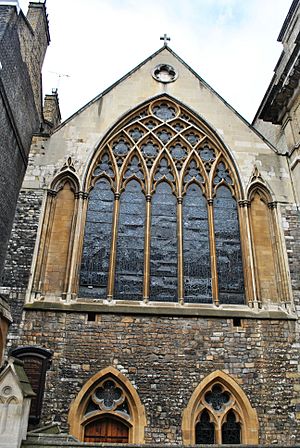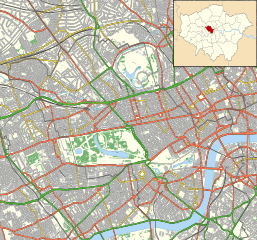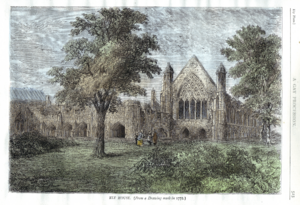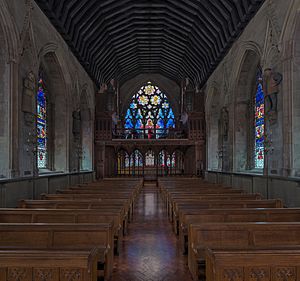St Etheldreda's Church facts for kids
Quick facts for kids St Etheldreda's Church, Ely Place |
|
|---|---|

Exterior of St Etheldreda's as viewed from Ely Place
|
|
| 51°31′07″N 0°06′27″W / 51.5187°N 0.1074°W | |
| Location | Holborn, London |
| Country | England |
| Denomination | Catholic Church |
| Website | stetheldreda.com |
| History | |
| Status | Active |
| Founded | 1290 |
| Dedication | St Etheldreda |
| Architecture | |
| Functional status | Parish church |
| Heritage designation | Grade I |
| Designated | 24-Oct-1951 |
| Administration | |
| Archdiocese | Westminster |
St Etheldreda's Church is a Catholic church located in Holborn, London. It's one of the oldest churches in London, built between 1250 and 1290 during the time of King Edward I. The church is named after Æthelthryth, also known as St Etheldreda. She was an Anglo-Saxon saint who started a monastery in Ely way back in 673.
This church was once the private chapel for the Bishops of Ely when they visited London. In the early 1600s, it was briefly used by the Spanish Ambassador as a special chapel, offering a safe place for English Catholics to worship. The Catholic Church bought the chapel in 1874, and it reopened in 1878. Today, it is one of the oldest churches in England still used by the Catholic Church.
Contents
About St Etheldreda's Church
St Etheldreda's Church has two main parts: an upper church, which is like a main chapel, and a crypt or undercroft below it. The church is still active and used for many services, including Masses, baptisms, weddings, and funerals.
Because St Etheldreda was often asked for help with throat infections, a special event called the Blessing of the Throats is held at the chapel every year. Interestingly, the Catholic chapel at the United States Military Academy, West Point in America was designed to look like St Etheldreda's.
History of the Church
Early Beginnings (13th-14th Century)
St Etheldreda's was built between 1250 and 1290. It was part of Ely Palace, the London home of the Bishops of Ely. In 1302, a nobleman named John, Earl of Warenne, promised his loyalty to King Edward II right here in the chapel. Later, in 1381, John of Gaunt, a very important royal duke, moved into the palace after his own home was destroyed during the Peasants' Revolt.
Changes During the Reformation (16th Century)
In 1534, a big change happened in England: Catholic Masses were made illegal. The Bishops of Ely still looked after the chapel, but it was then used for Anglican worship after the English Reformation.
In 1576, a part of the palace and its lands, including the chapel, was leased to Sir Christopher Hatton. He was a favorite of Elizabeth I. The rent was very low, which made people think Queen Elizabeth had pressured the bishop. During Hatton's time, the church's lower part (the crypt) was even used as a tavern! Shakespeare mentioned Ely Palace in two of his famous plays, Richard II and Richard III.
Turbulent Times (17th Century)
In 1620, the upper church was given to Count Gondomar, the Spanish ambassador. He used it as his private chapel, and it was treated as if it were on Spanish land. This meant Catholic worship, which was still illegal in England, was allowed there.
However, this only lasted two years. During a disagreement between England and Spain, Gondomar returned home, and his successor was not allowed to use the chapel. Later, during the English Civil War in 1642, the palace and church were taken over by Parliament. They used it as a prison and a hospital. During Oliver Cromwell's time (1649–1660), most of the palace was torn down, and its gardens were ruined.
New Beginnings (18th-19th Century)
In 1772, a new law allowed the Bishops of Ely to sell the property. The site, including the chapel, was sold to Charles Cole, an architect. He tore down all the buildings except the chapel and built Ely Place. The chapel was then greatly updated in the Georgian style and reopened in 1786.
In 1820, a group called the National Society for the Education of the Poor took over the chapel. They wanted to help Irish Catholic immigrants in the area. The church closed for a short time after this. In 1836, it reopened for Anglican worship, but it closed again. In 1843, Welsh Anglicans leased the chapel and held services in the Welsh language.
In 1874, the chapel was put up for sale. Father William Lockhart, a Catholic priest, bought it for £5,400. He was very happy to save the historic building.
"We heard of the proposed sale of Ely Chapel, and sent an agent to bid. We paid £5,400, which was less than the value of the freehold ground on which it stands. The day after we had made the purchase, the clergyman of the Welsh congregation called on me to offer a considerable advance on the sum we had paid. 'Well, sir.' he said when I declined to sell, 'I am sorry we have lost the old place, but I am glad it has passed into your hands, for you will appreciate its beauty, and, I have no doubt, restore it in a way we should never do.'"
Under Father Lockhart's guidance, the church was restored to its original 13th-century look by George Gilbert Scott. Another architect, John Francis Bentley, designed new features like a choir screen and an organ. A special relic (a piece of St Etheldreda's hand) was given to the church and is kept near the main altar.
The restoration was finished in 1878. A Catholic Mass was celebrated in St Etheldreda's for the first time in over 200 years! The upper church officially reopened in 1879 on the Feast of St Etheldreda (June 23). For many years, St Etheldreda's was the oldest Catholic church building in England. However, since 1971, the 12th-century church of Ss Leonard & Mary in Malton, North Yorkshire, has held that title.
Modern Times (20th-21st Century)
In 1925, the chapel was recognized as an ancient monument by the Royal Commission on Historical Monuments.
During the Blitz in May 1941, a bomb hit the church. It tore a hole in the roof and destroyed the Victorian stained glass windows. It took seven years to fix the damage to the building.
In 1952, new stained glass windows were put in by Joseph Nuttgens. The east window shows the Trinity, the evangelists Matthew, Mark, Luke, and John. It also features the Virgin Mary, St Joseph, St Bridget of Kildare, and St Etheldreda. The windows on the south wall show scenes from the Old Testament, and those on the north wall show scenes from the New Testament.
In the 1960s, statues of English Catholic martyrs were added along the north and south walls. These include important figures like St. Edmund Gennings, St. Swithun Wells, St Margaret Ward, and St Anne Line.





